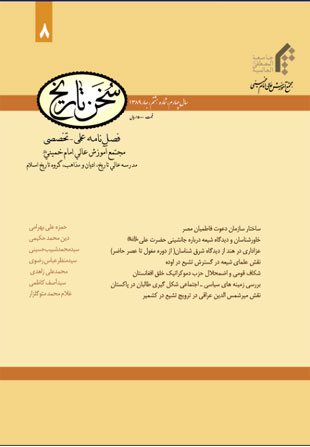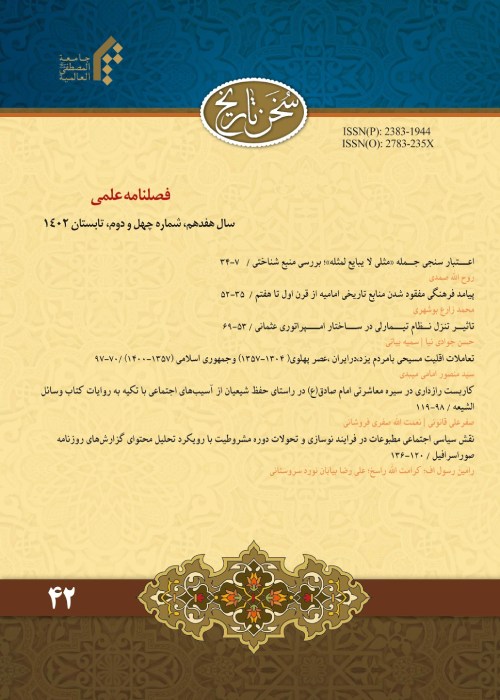فهرست مطالب

نشریه سخن تاریخ
پیاپی 8 (بهار 1389)
- بهای روی جلد: 15,000ريال
- تاریخ انتشار: 1389/04/20
- تعداد عناوین: 8
-
چکیده مقالات به زبان انگلیسیصفحه 184
-
Page 3The existence of a preaching and missionary institution called "invitation organization" was one of the factors by which Ismailia sect grew and developed and eventually ended to an enormous Islamic empires by the name of Fatimid in Egypt and Morocco within the fourth century. The organization was equipped with a sophisticated structure and hierarchy orderand it seemed to be one of the reasons of its efficiency.From the main points of invitation organization's structure, its pecking order can be highlighted that while being harmonious with the celestial world and orders of the terrestrial world, starts with Natiq, Asas and Imam and while holding having seven grades ends with Mustajeeb. Another important phase of this organization lies with different stages of invitation which the Ismailia instructions move in seven or nine stages from simple and exoteric knowledge to sophisticated and esoteric one. The third phasepertains to the invitation realm which according to their instructions the world is divided into twelve islands and for each of the island a hojjat (one of the stages of invitation) is determined. In this article the third phases of the structure of "invitation organization" is going to be studied.
-
Page 26Since the religion of Islam is the last and the most comprehensive divine religion and Muhammad being the last of the prophets, how does it seem possible that the prophet Muhammad should not designate any one after him for continuation and expansion of religious culture and his prophetic outputs? From one hand the internal foes of Islam (hypocrites) and external ones (Rome and Iran) were keenly lurking to find an opportunity for bringing a new approach in Islamic leadership realm so to achieve their own purposes. Thus from an eminent figure such as the prophet Muhammad (P.B.U.H) who had intensely looked for formation and continuation of an ideal society based on human and divine values, it is improbable and unlikely that he should choose none as a successor and a caliph and leave the Muslim community on their own status.Therefore, the Shiite historians are of the idea that the prophet Muhammad as the previous prophets chose a successor for himself. He the Excellency, in variety of places and occasions in particular in Ghadir Khum event chose the commander of faithful Imam Ali as his successor not only for the virtues and competence he enjoyed but also for the sake of Allah's determination which was more decisive. But unfortunately after the demiseof the prophet Muhammad (P.B.U.H) some of the writers turned a blind eye to his succession which ought to be studied critically on its appropriate place. So, the Shiites are in firm belief of the fact that the prophet Muhammad (P.B.U.H) chose Imam Ali (A.S) as his successor.
-
Page 70With respect to the issue of mourning for Imam Hussein (A.S) and its growth throughout the world in universal level, it is necessary to launch a series of researches in this regard. The Indian Territory is one of the important mourning centers in the world. Thus in this country it seems highly essential to pay attention to mourning. The writers and researchers have more or less paid attention about the very topic.The present writing deals with the subject from the Orientalist's standpoint about mourning (from Mongolian period up to contemporary period) and examines their views in this respect. It has been approved in the article that the Orientalists have written some writings in the subject and paid attention to the genesis of mourning in India alongside its ups and downs in Mongolian period and then its flourish on the period of Avadeh's kings.Moreover, there are some indications to the present style of mourning of the Indians.
-
Page 80The spread of religion and creed is one of the prominent proceedings and missions of religious intellectuals and clergies which can face in various periods of time with different processes and is to counter abundant hurdles and challenges. Avadeh is counted as an efficient and notable place in India which the rest of the Indian suburbs had been impressed by. This place had enjoyed a distinguished cultural and religious status in India. Thus, to study historically and elaborate on Shiite clergies and intellectual's role in spreadand expansion of Shiism in the very district forms today's scientific needs which this writing undertakes. Establishment of cultural centers such as library, religious schools,scientific centers, training students and setting up cultural compounds from one hand and challenging the rivalry groups and factions such as Sufism, traditionalists, Wahabis and Naseby from other hand, are of the most significant proceedings of the Shiite clergies in Avadeh. These are their enterprises and initiatives which the paper has touched.
-
Page 100The national gap in political developments of societies is of great importance in sociology of politics. In the present article it is tried to reread and describe the decline of the people's Democratic Party of Afghanistan under the shadow of this gap.The socio-political developments of Afghanistan are getting formation under the impression of such ethnic schism. The racial gaps such as Pashtoon - Persina, Pashtoon - Hazarah, and Pashtoon - Uzbak are from these national gaps. Such gaps which exist in the core point of an Afghan society and do exist amongst the various tribes had impressive impacts on decline of the people's Democratic Party. One of the reasons for which itdeclined is this slit and schism.
-
Page 116Taliban is one of the phenomena of Afghanistan's contemporary history that for the first time has come to existence and emerged in 1994 A.D following the great power's competition and occupation of Afghanistan by Soviet Union. This movement through the generous conducts and contributions of the regional countries such as Pakistan and Saudi Arabia flourished and developed.The Soviet Union occupied Afghanistan in 27th September of 1979 and from that time on the Afghan fighters being backed by USA and regional countries started to resist and oppose the occupation of Soviet Union which eventually ended to the red army's expulsion and removal from the country.The last soldiers of the Soviet Union left the Afghanistan territory on February of 1989. With the removal of the red army from Afghanistan the United States of America did not remain loyal to Genève's agreement and due to the competition she had with the Soviet Union supported the Afghan campaigners and the Afghanistan territory became a ground for the intense competitions of great powers during the cold war.With the ending of cold war and removal of Soviet Union's army from Afghanistan, Pakistan was changed to a good canal for flowing of supports to Afghan fighters. This country with some internal changes went towards establishing thousands of religious schools with fanatic Salafi tendency which was accompanied with the openhanded contributions of Arabic countries around Persian Gulf in particular Saudi Arabia.The role of Pakistan in creation, bringing up, sustenance and advocating of the radical group of Taliban is something obvious and evident.
-
Page 169Mir Shamsuddin Iraqi was born in Solghan of Iran and came to Kashmir twice. The first time he came in Kashmir was in 822 A.H as an ambassador of Mirza Hussein Bayqra the ruler of Khorasan. He after 8 years of residence in Kashmir returned to Khorasan. His second visit of the region goes to the year 902 A.H which was carried out in response to Qasem Noorbakhsh's request.In this round he had come for preaching of Islam and Shiism in Kashmir and did it well with all his abilities and full determination. Moreover, in this regard and stage, he crossed all the obstacles and could do the things which were unprecedented in the region. He in the first phase of his activities could enter the influential figures in the Shiite circle and then through their contribution in particular the prime minister of Kashmir Malik Musa Rinahcould guide 24 thousand Hindus family toward Shiism. In a very short period he could make a sermon widely known in exhortation of Shiite infallible Imams in Kashmir's mosques.


